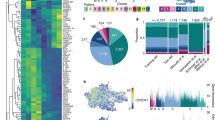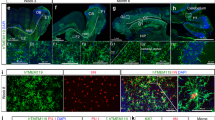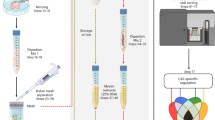Abstract
There is increasing interest in the isolation of adult microglia to study their functions at a morphological and molecular level during normal and neuroinflammatory conditions. Microglia have important roles in brain homeostasis, and in disease states they exert neuroprotective or neurodegenerative functions. To assay expression profiles or functions of microglia, we have developed a method to isolate microglial cells and infiltrating leukocytes from adult mouse brain. This protocol uses a digestion cocktail containing collagenase and dispase, and it involves separation over discontinuous percoll gradients. Isolated cells can be used for RNA analysis, including RNase protection analysis (RPA), quantitative RT-PCR, high-density microarray, proteomic or flow cytometric characterization of cell surface markers or adoptive transfer. Cell isolation can be completed in less than 4 h.
This is a preview of subscription content, access via your institution
Access options
Subscribe to this journal
Receive 12 print issues and online access
$259.00 per year
only $21.58 per issue
Buy this article
- Purchase on Springer Link
- Instant access to full article PDF
Prices may be subject to local taxes which are calculated during checkout



Similar content being viewed by others
References
Del Rio-Hortega, P. in Cytology and Cellular Pathology of the Nervous System (ed., Penfield, W.) 481–584 (Paul B. Hoeber, New York, 1932).
Perry, V.H. Macrophages and the Nervous System 62–87 (R.G. Landes, Austin, 1994).
Carson, M.J. Microglia as liaisons between the immune and central nervous systems: Functional implications for multiple sclerosis. Glia 40, 218–231 (2002).
Streit, W.J. Microglia as neuroprotective, immunocompetent cells of the CNS. Glia 40, 133–139 (2002).
Rivest, S. et al. How the blood talks to the brain parenchyma and the paraventricular nucleus of the hypothalamus during systemic inflammatory and infectious stimuli. Proc. Soc. Exp. Biol. & Med. 223, 22–38 (2000).
Aloisi, F. Immune functions of microglia. Glia 36, 165–179 (2001).
Vallat-Decouvelaere, A.V. et al. Neurotoxicity and neuroprotection, two aspects of microglial activation in human immunodeficiency virus (HIV) infection. Ann. Pathol. 24, 31–44 (2004).
Byrnes, K.R. et al. Expression of two temporally distinct microglia-related gene clusters after spinal cord injury. Glia 53, 420–433 (2006).
Gebicke-Haerter, P.J. Microarrays and expression profiling in microglia research and in inflammatory brain disorders. J. Neurosci. Res. 81, 327–341 (2005).
Albright, A.V. & Gonzalez-Scarano, F. Microarray analysis of activated mixed glial (microglia) and monocyte-derived macrophage gene expression. J. Neuroimmunol. 157, 27–38 (2004).
Moran, L.B., Duke, D.C., Turkheimer, F.E., Banati, R.B. & Graeber, M.B. Towards a transcriptome definition of microglial cells. Neurogenetics 5, 95–108 (2004).
Davalos, D. et al. ATP mediates rapid microglial response to local brain injury in vivo. Nat. Neurosci 8, 752–758 (2005).
Nimmerjahn, A., Kirchhoff, F. & Helmchen, F. Resting microglial cells are highly dynamic surveillants of brain parenchyma in vivo. Science 308, 1314–1318 (2005).
Stence, N., Waite, M. & Dailey, M.E. Dynamics of microglial activation: a confocal time-lapse analysis in hippocampal slices. Glia 33, 256–266 (2001).
Lehnardt, S. et al. A mechanism for neurodegeneration induced by group B streptococci through activation of the TLR2/MyD88 pathway in microglia. J. Immunol. 177, 583–592 (2006).
Esen, N. & Kielian, T. Central role for MyD88 in the responses of microglia to pathogen-associated molecular patterns. J. Immunol. 176, 6802–6811 (2006).
Hussain, S.F. et al. The role of human glioma-infiltrating microglia/macrophages in mediating antitumor immune responses. Neuro. oncol. 8, 261–279 (2006).
Cardona, A. et al. Control of microglial neurotoxicity by the fractalkine receptor. Nat. Neurosci. 9, 917–924 (2006).
Huang, D. et al. The neuronal chemokine CX3CL1/fractalkine selectively recruits NK cells that modify experimental autoimmune encephalomyelitis within the central nervous system. FASEB J. 20, 896–905 (2006).
Jung, S. et al. Analysis of fractalkine receptor CX(3)CR1 function by targeted deletion and green fluorescent protein reporter gene insertion. Mol. Cell Biol. 20, 4106–4114 (2000).
Sedgwick, J.D. et al. Isolation and direct characterization of resident microglial cells from the normal and inflamed central nervous system. Proc. Natl. Acad. Sci. USA. 88, 7438–7442 (1991).
Ford, A.L., Goodsall, A.L., Hickey, W.F. & Sedgwick, J.D. Normal adult ramified microglia separated from other central nervous system macrophages by flow cytometric sorting. Phenotypic differences defined and direct ex vivo antigen presentation to myelin basic protein-reactive CD4+ T cells compared. J. Immunol. 154, 4309–4321 (1995).
Juedes, A.E. & Ruddle, N.H. Resident and infiltrating central nervous system APCs regulate the emergence and resolution of experimental autoimmune encephalomyelitis. J. Immunol. 166, 5168–5175 (2001).
Becher, B., Durell, B.G. & Noelle, R.J. IL-23 produced by CNS-resident cells controls T cell encephalitogenicity during the effector phase of experimental autoimmune encephalomyelitis. J. Clin. Invest. 112, 1186–1191 (2003).
Heppner, F.L. et al. Experimental autoimmune encephalomyelitis repressed by microglial paralysis. Nat. Med. 11, 146–152 (2005).
Ponomarev, E.D., Shriver, L.P., Maresz, K. & Dittel, B.N. Microglial cell activation and proliferation precedes the onset of CNS autoimmunity. J. Neurosci. Res. 81, 374–389 (2005).
Bergmann, C.C., Altman, J.D., Hinton, D. & Stohlman, S.A. Inverted immunodominance and impaired cytolytic function of CD8+ T cells during viral persistence in the central nervous system. J. Immunol. 163, 3379–3387 (1999).
Maric, D. et al. Anatomical gradients in proliferation and differentiation of embryonic rat CNS accessed by buoyant density fractionation: alpha 3, beta 3 and gamma 2 GABAA receptor subunit co-expression by post-mitotic neocortical neurons correlates directly with cell buoyancy. Eur. J. Neurosci. 9, 507–522 (1997).
Lisak, R.P., Pleasure, D.E., Silberberg, D.H., Manning, M.C. & Saida, T. Long term culture of bovine oligodendroglia isolated with a Percoll gradient. Brain Res. 223, 107–122 (1981).
Thorne, B., Wonnacott, S. & Dunkley, P.R. Isolation of hippocampal synaptosomes on Percoll gradients: cholinergic markers and ligand binding sites. J. Neurochem. 56, 479–484 (1991).
Huang, D. et al. Pertussis toxin-induced reversible encephalopathy dependent on monocyte chemoattractant protein-1 overexpression in mice. J. Neurosci. 22, 10633–10642 (2002).
Elhofy, A. et al. Transgenic expression of CCL2 in the central nervous system prevents experimental autoimmune encephalomyelitis. J. Leukoc. Biol. 77, 229–237 (2005).
Acknowledgements
This work was supported by the National Institutes of Health (NS32151 to R.M.R.), the Dana Foundation (to R.M.R.) and the National Multiple Sclerosis Society (FG 1528-A-1 and TA 3021-A-1 to A.E.C.).
Author information
Authors and Affiliations
Corresponding author
Ethics declarations
Competing interests
The authors declare no competing financial interests.
Rights and permissions
About this article
Cite this article
Cardona, A., Huang, D., Sasse, M. et al. Isolation of murine microglial cells for RNA analysis or flow cytometry. Nat Protoc 1, 1947–1951 (2006). https://doi.org/10.1038/nprot.2006.327
Published:
Issue Date:
DOI: https://doi.org/10.1038/nprot.2006.327
This article is cited by
-
Current methods for the microglia isolation: Overview and comparative analysis of approaches
Cell and Tissue Research (2024)
-
Correction to: Castor1 overexpression regulates microglia M1/M2 polarization via inhibiting mTOR pathway
Metabolic Brain Disease (2023)
-
Senescent accelerated prone 8 (SAMP8) mice as a model of age dependent neuroinflammation
Journal of Neuroinflammation (2021)
-
Essential roles of plexin-B3+ oligodendrocyte precursor cells in the pathogenesis of Alzheimer’s disease
Communications Biology (2021)
-
Role of miRNAs shuttled by mesenchymal stem cell-derived small extracellular vesicles in modulating neuroinflammation
Scientific Reports (2021)
Comments
By submitting a comment you agree to abide by our Terms and Community Guidelines. If you find something abusive or that does not comply with our terms or guidelines please flag it as inappropriate.



